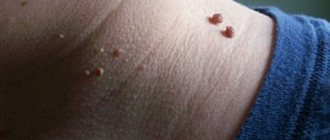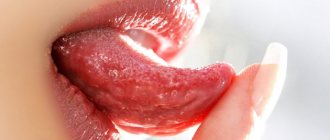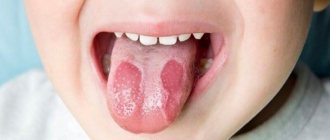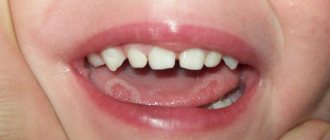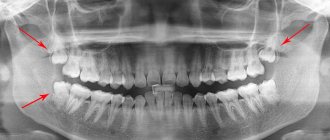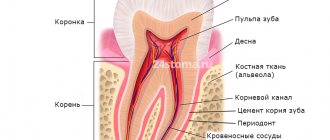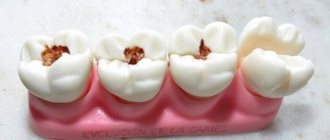The appearance of papilloma in the oral cavity can be caused by the following factors:
- infection;
- immune disorders;
- vitamin deficiency;
- wearing plates to correct bites and uncomfortable dentures;
- influence of caustic substances and high temperatures;
- oral injuries;
- genetic predisposition;
- pathologies of the endocrine system;
- use of other people's hygiene items;
- emotional shock, prolonged state of stress;
- hormonal dysfunctions.
Warts in the mouth can be isolated, however, as a rule, the growths appear in small groups. Most often they are localized on the gums, palate, tongue, inner surface of the cheeks, tonsils and lips.
Papillomas on the oral mucosa can cause significant discomfort to the patient, which motivates him to think about removing the growth. However, inconvenience is not the only reason that determines the need for papilloma surgery. In some cases, the occurrence of warts can affect chewing, eating and may affect diction. New growths in the mouth are characterized by increased pain, which is due to their close location to the nerve endings. In addition, any benign neoplasm can degenerate into malignant. Therefore, if you find warts in the oral cavity, you should consult a specialist.
An important step before removing papilloma will be a preliminary examination of the patient. It includes a consultation with a dermatologist, otolaryngologist, dentist and oncologist (if the growth is suspected of being malignant). The patient may also be shown a cytological and histological examination of tissues, which will determine the nature of the neoplasm. Carrying out a comprehensive diagnosis makes it possible to identify hidden foci, the number, growth and size of papillomas, assess the patient’s health status, and also choose the most appropriate tactics to combat tumors in the mouth. To effectively eliminate papilloma in the oral cavity, complex treatment is carried out, which includes sanitation of the oral cavity, excision of papilloma and drug treatment. According to experts, it is precisely this tactic of combating pathological neoplasms that will reduce the risk of re-formation of warts and prevent the occurrence of adverse side effects.
What is papilloma on the tongue?
It is not difficult to detect the presence of a growth on the surface of the tongue. This growth is characterized by a rounded shape, protrudes above the mucous membrane and has a wide base.
Papillomas on the tongue are a dangerous manifestation of HPV. Symptoms: growths on the tongue are round in shape, up to 2 cm in size, similar to a nipple, with a soft consistency.
Diagnostics: differential diagnosis with oncological diseases of the tongue. Treatment: antiviral, immunocorrectors, removal.
The size of the formation is from 2 mm to 2 cm. Location: mainly on the back or edges of the tongue. In some cases - at its tip or under it. When the tumor is located near the root of the tongue, it can only be detected during a doctor’s examination or in case of extensive growth.
Removal of papillomas
Papillomas are benign formations.
From the outside, the papilloma looks like a nipple, its color is similar to the shade of nearby tissues, and its structure is soft. Both single and multiple growths form on the surface of the tongue.
Often, the presence of papillomas on the tongue is not given due attention and a specialist is visited if the growths have become impressive in size or their number has increased significantly.
The papilloma itself does not cause pain or itching. But due to frequent injury to the growth, there is severe pain and bleeding. In addition, the growth interferes with chewing, swallowing, talking, and sometimes breathing.
Papilloma on the tongue is often found in the practice of dentists and ENT doctors.
Removal is usually carried out by otorhinolaryngologists. The radio wave method is used more often than others.
Dermatovenerologist, cosmetologist
Zhikhoreva Inna Viktorovna
6 years experience
Features of the pathogen:
- Laboratory signs noticeable immediately after infection. It will take approximately 3 months before growths are detected.
- The virus can manifest itself in people with reduced immunity. In this regard, experts advise people with HPV to be tested for HIV.
- In some cases, it is possible to recover on your own. During the recovery period, warts can disappear on their own.
- Elimination of external symptoms does not lead to elimination of the viral agent. There is no specific etiological therapy; antiviral agents are used in treatment. They are effective in the presence of herpesvirus, hepatitis and other infections.
Scalpel against papilloma
Surgery to remove papilloma involves excision of the tumor with a scalpel. Doctors usually recommend this procedure if the papilloma has grown by 3 centimeters or more.
Initially, the doctor treats the growth and the surrounding skin with alcohol. After this, local anesthesia is administered and excision begins.
The remains are sent for histology, and the wound is sutured with a cosmetic suture.
After 10-14 days, the wound heals, leaving virtually no visible marks.
Kinds
Having identified growths on the surface of the tongue or in the throat, you need to establish what type of condyloma this is. They are divided into 2 types:
- Reactive. Papillomas are a consequence of the adverse effects of various irritants. These are mainly mechanical, chemical, thermal or infectious lesions.
- Neoplastic. Seen extremely rarely. Outwardly they resemble ordinary multiple nodular growths. They are presented in groups or single papules.
Papillomas that appear in children and adults on the surface of the tongue or in the throat are also divided into 2 types.
Pointed
This is a growth under the tongue that has a light pink tint and a sharp shape. In some cases they can grow.
Externally similar to cauliflower inflorescence. A similar neoplasm forms on a stalk. Small in size, but causes significant pain.
Sometimes there is discomfort during swallowing. Acute papilloma gets in the way, rubbing against the teeth and cheeks. The favorite place for this wart will be the area under the tongue.
You need to be extremely careful. Self-therapy is prohibited. Treatment is permissible only under the supervision of a specialist.
Flat
They are characterized by clearly defined contours and protrude somewhat above the surface of the skin. They are located in the throat, on the tonsils, on the small tongue. They do not cause any particular pain. They are extremely difficult to detect.
Why can our articles be trusted?
We make health information clear, accessible and relevant.
- All articles are checked by practicing doctors.
- We take scientific literature and the latest research as a basis.
- We publish detailed articles that answer all questions.
Any examination must be carried out by a doctor in a hospital setting. Self-treatment can have consequences for a person’s life and health. Therapy involves the use of various medications. There is no need for surgical intervention.
When such growths appear in children, their difference will be excessive growth of the tissues of the mucous membrane of the small tongue.
How to diagnose papillomatosis?
Pathological formations that appear on the tongue cause anxiety in a person, and the first thing he tries to do is find out what it could be. Papillomas are quite easy to diagnose even by sight. They come in two types and look different. Symptoms other than the presence and appearance of a wart are not needed to diagnose the disease.
| Type of papilloma | Characteristic |
| Pointed papillomas | They are pinkish in color and look like papillae. The stalk on which they are attached to the tongue can be very large, which increases the likelihood of injury and even complete tearing off of the wart. This new growth resembles cauliflower in appearance. |
| Flat papillomas | Flat elements that slightly rise above the level of the mucosa and are very different in color from the surrounding tissues. Often they exist for a long time without treatment, since they do not cause discomfort or pain to a person. |
A characteristic feature of papillomas is the appearance of bleeding ulcerations at the site of the torn wart. Such injuries negatively affect the wart cells and over time they can begin to degenerate into cancerous ones.
There are two types of oral papillomatosis:
- Reactive - warts arise due to constant and frequent exposure to irritants (thermal, viral, chemical or mechanical irritation of the mucous membrane).
- Neoplastic - warts are present in large numbers in the form of nodular neoplasms, can be collected in groups, or are located throughout the oral cavity.
Neoplastic papillomatosis of the oral cavity is quite rare. More often, single genital warts can be seen on the tongue.
Location zones
The growths select areas on the oral mucosa that are subject to regular trauma. When the stroma is involved in the ongoing inflammation, the growth grows rapidly. This is because the stroma is the basis for the organs.
It is formed from connective tissue, which is saturated with blood and lymphatic vessels with multiple nerve endings. Such an environment is favorable for condyloma. It immediately begins to grow, turns into an ulcer, bleeds and causes severe discomfort.
New growths that are located singly on the surface of the tongue need special attention. Similar symptoms are typical for females. The result will be neuralgia.
Even if the condylomas are in a place where they are invisible, the sensations in the oral cavity cause significant discomfort.
Contraindications to laser removal of HPV formations
There are few contraindications to the procedure, but they should be followed strictly. These are:
- diabetes mellitus 1st and 2nd degree;
- oncological diseases;
- diseases of the endocrine system;
- period of exacerbation of herpes;
- epilepsy;
- thrombocytopenia;
- autoimmune diseases;
- photodermatosis;
- inflammatory processes, including those accompanied by fever.
Neglecting contraindications can cause pigmentation in photodermatosis, swelling in autoimmune diseases and allergies, and keloid scars in diseases of the endocrine system (thyroid gland).
Causes
Papilloma on the tongue is difficult to remain unnoticed. Unpleasant sensations, burning, and pain are concentrated at a certain point on the surface of the tongue.
Test for human papillomavirus
The human papillomavirus (HPV) manifests itself differently in each case.
The patient looks at the affected area and discovers a small white growth that looks like a purulent pimple. The main reason for the appearance of condylomas on the surface of the tongue is human infection with HPV.
This is influenced by a number of provoking factors:
- Reduced functioning of the immune system.
- Tobacco smoking.
- Excessive alcohol consumption.
- Taking drugs.
- Chaotic sex life.
- Constant colds .
- Self-administration of oral contraceptives.
Symptoms
Before visiting a doctor, a person must discover what worries him. It is necessary to identify the location of unpleasant sensations on the surface of the tongue. In children, this is a shooting or aching pain; in adulthood, it is a feeling of a foreign body or persistent discomfort in a certain place on the tongue.
More specifically, it is possible to establish papilloma based on the following signs:
- The growth is located on the leg.
- The surface of the condyloma is soft.
- The shade of the wart is similar to the shade of the tongue.
- Sizes range from 2 mm to 2 cm.
The favorite place for growth is the side walls of the tongue. Less often - under it or at the tip.
The neoplasm does not provoke severe pain, but discomfort or a feeling of a foreign body exists. Often there is more than one growth; upon careful examination, it is possible to identify a whole group of minor neoplasms.
A proper attitude towards your own health will help you identify papilloma on the tongue in a timely manner.
Diagnostics
The growth on the front surface of the tongue is immediately visible. It interferes with normal eating, conversation, and bleeds due to the fact that it is easy to get caught and damaged.
This provokes unpleasant pain. When the condyloma is located in the oral cavity, for example, on the soft palate or on the back of the tongue, it is possible to notice it by accident when examining the patient by a specialist. Having discovered a growth, the doctor will examine its structure.
Papilloma is soft in structure. And the shade is somewhat lighter than the mucous membrane. When it is in the oral cavity, it will be rough.
What is different is the new growth in the child: condylomas seem to cover the tongue, cover the entire soft palate, and reach the tonsils. It is much easier to detect in children than in adults.
Particular attention should be paid when examining elderly people: they often develop a cancerous tumor resembling condyloma. Only with cancer at the base of the tissue from which the growth is formed is there a clear compaction.
Who diagnoses HPV?
A dermatologist treats skin diseases, and you should first make an appointment with him if you find epithelial growths in the form of a wart or polyp on your skin or mucous membrane. A dermatologist will conduct an examination, and if papilloma is suspected, he will prescribe an examination to confirm the diagnosis and determine the type of virus.
To diagnose HPV, cytological examination of polyp tissue is usually sufficient. This is a PCR (polymerase chain reaction) analysis based on identifying the DNA structure of the pathogen. The PCR method is considered the most accurate and objective; it makes it possible to determine not only the type of virus, but also its quantity in the body.
If necessary, the following can also be carried out:
- enzyme-linked immunosorbent assay, which identifies marker proteins indicating the presence of infection;
- Digene test (this method is used to determine the type of papillomavirus in a smear taken from the cervical mucosa);
- cytological analysis of tissue for the presence of malignant cells.
Treatment
A neoplasm under the tongue or in the oral cavity is treated under the supervision of a dermatologist. After conducting a thorough and comprehensive examination, he must prescribe medications. In some cases, condyloma can be removed surgically.
Self-medication is dangerous with complications!
Attention
Despite the fact that our articles are based on trusted sources and have been tested by practicing doctors, the same symptoms can be signs of different diseases, and the disease may not proceed according to the textbook.
Pros of seeing a doctor:
- Only a specialist will prescribe suitable medications.
- Recovery will be easier and faster.
- The doctor will monitor the course of the disease and help avoid complications.
find a doctor
Do not try to treat yourself - consult a specialist.
Drug therapy
Drug treatment consists of following the following instructions:
- The use of local therapy with an oil solution of vitamin A in the absence of indications for surgical removal of the growth.
- The use of interferons, which reduce the amount of viral DNA at the site of pathology.
- Simultaneous use of immunostimulating antiviral drugs.
At the moment, there is no effective remedy that could help completely get rid of HPV. The use of any medications must be agreed with a specialist.
Antiviral treatment
Antiviral therapy involves the use of medications to eliminate the development of HPV. Vitamin complexes are prescribed; they help activate the body's defenses. The specialist recommends balancing your diet and leading an active lifestyle.
According to statistics, patients with papillomas have a weakened immune system. People with high immunity are carriers of HPV, but at the same time they do not have any manifestations on the skin.
The specialist prescribes immunomodulating agents, a complex of vitamins and restorative medications. It should be remembered: immunity cannot be increased in one day with pills. Medicines are aimed at maintaining a weakened body during a critical period.
Vaccination
HPV is one of the few strains of viruses against which a vaccine has been developed. It includes organic substances that are similar in structure to the structure of living HPV viruses. Immunity against real pathogens is developed perfectly.
Before vaccination it is necessary to exclude:
- Pregnancy. Get tested or have a blood test.
- Use of serious medications .
- Other vaccinations.
- Serious diseases .
Vaccinations are given intramuscularly. Dangerous side effects are observed extremely rarely.
Removal
The method by which the papilloma will be removed must be chosen by the treating specialist. It depends on the location and characteristics of the body. There are the following ways to eliminate tumors:
- Surgical excision using a surgical scalpel. After the procedure, “cauterization” is performed. A similar technique is used in the presence of single growths or when they are inaccessible and it is impossible to use other methods.
- Laser elimination. The most effective, painless method with no adverse effects. The disadvantage is the high cost of the procedure.
- Electrocoagulation. The method involves cauterizing the growth with an electric current. The disadvantages include painful manipulation and a long rehabilitation period.
- Radio wave surgery. The technique is similar to the previous one, only instead of current, high-frequency radio waves act on the papilloma. The pain is insignificant, the number of adverse effects is minimal and the rehabilitation period is short.
- Cryodestruction. The most unpopular surgical method for eliminating papilloma on the tongue. The tumor is removed by influencing it with cold. The wart is frozen to liquid nitrogen temperature. The growth will be frozen and die within a week.
If the technique involves excision of the wart, then the biomaterial is sent for histological diagnosis in order to analyze the structure of the growth.
Methods for removing tumors on the mucous membrane of the tongue
Laser exposure
The most effective method due to the selectivity of the tissue being burned. Modern devices are easily adjusted exclusively to tumors with minimal capture of healthy cells. The risk of complications after the procedure is less than 1%. The laser is aimed specifically at the formation and the optimal program is selected (specific wavelength, time and depth of exposure) depending on the type of growth. There are both automatic programs with fixed values, and a number of adjustable parameters for atypical forms of papillomas. The tissues are burned out in layers; in case of pointed forms, the formation is cut off at the very base. Formations of different localizations, including in the area of the frenulum and root, are available for removal.
Electrocoagulation
The method is based on removing the growth using an electric knife. The method is less effective than the previous one, since significant injury to surrounding tissue occurs. Clinical manifestations of a burn do not occur immediately, but over the course of several days, since overheating affects not only nearby cells, but also cells of healthy tissue located at some distance. A wound surface appears at the site of the removed lesion, which must be treated with antiseptics to avoid infection. The tissues are burned in layers, the average exposure time is 20-60 seconds. Electrocoagulation is used mainly for single papillomas localized on the tip or lateral surfaces of the tongue.
Radio wave treatment
A low-traumatic method that allows you to remove several formations at once (important for papillomatosis). The method is based on exposure to a radio frequency wave, which leads to heating and destruction of formation cells. The exposure time is selected individually.
Cryotherapy
In this anatomical area, it is used less frequently than other methods due to the capture of a large amount of tissue. After use, a chemical burn is formed at the site of formation, which takes a long time to heal (about 14 days), which increases the risk of a secondary infection. They are used more often for formations with a large area. The active ingredient is liquid nitrogen. Exposure time from 10 to 50 seconds.
Surgical excision
The method involves removing tumors using a scalpel. They are rarely used due to the high level of trauma, the inability to remove a large number of formations at once and the additional risk of contamination in the case of viral papillomas. Typically, surgical removal is resorted to in case of localization in the area of the tongue root or in case of suspicious neoplasms for further cytological and histological examination. It is performed under local anesthesia. In some cases, sutures are placed after excision for additional hemostasis. Dressings are indicated until the wound is completely healed.
Other methods
The use of ointments or gels for local treatment of papillomas of a given anatomical area is not only ineffective, but is also associated with a high risk of chemical burns of the tongue and oral cavity.
Sometimes, subject to the approval of the attending physician, it is allowed to treat formations with home methods. As a rule, home treatment acts as an auxiliary method that complements the main therapy.
A few recipes as an example:
- Pour 2-3 tbsp. l. celandine and 1 tbsp. l chamomile 300 ml water. Bring to a boil, leave for 1-2 hours. Rinse your mouth 3-4 times a day for 14 days.
- Mix calendula, chamomile and mint in equal proportions. Pour 150 ml of water, boil, cool, strain. Rinse your mouth with the broth for 2 weeks.
Danger
When papillomas occur on the tongue, the patient experiences some discomfort. So, during eating, the growth can easily come off. In addition, the formations are visible when speaking and contribute to changes in speech.
Pointed-type formations cause not only physical, but also psychological inconvenience. Against the background of this condition, a person may experience embarrassment at an appointment with a dentist or ENT specialist. Complexes also appear when communicating with other people.
The localization of growths on the inside of the oral cavity poses a serious danger, since they can provoke the penetration of another infection, resulting in an increased risk of blood poisoning. All this often leads to cancer, which often ends in death.
Sanitation of the oral cavity in the treatment of papillomas
Since pathogenic microorganisms present in the mouth can lead to an exacerbation of HPV, before operating on papilloma, special attention is paid to the sanitation of the oral cavity. This integral stage of wart treatment includes the following activities:
- Treatment of teeth affected by caries;
- Elimination of inflammatory processes;
- Elimination of plaque and tartar;
- Neutralization of pathologies affecting the gums;
- Enhanced oral care (regular brushing of teeth, removing food debris with dental floss, rinsing the mouth with prescribed medications).
Prevention
It is not difficult to take measures to protect against this pathology. The likelihood of HPV infection should be minimized:
- avoid casual and unprotected sexual contacts, use contraception;
- use personal hygiene items;
- Get HPV vaccine
When infection has already occurred, it is necessary to prevent the activation of the viral agent due to weakened immunity:
- consume vitamin complexes;
- get rid of bad habits;
- avoid stressful situations and overwork.
You should not neglect HPV infection and leave its manifestations without proper treatment from a qualified doctor.
Papilloma on the tongue is a dangerous formation that requires a mandatory visit to a highly qualified doctor. The patient’s main task will be to timely detect the growth and seek help from a specialist.
